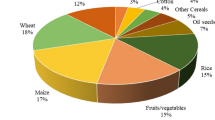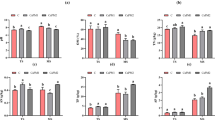Abstract
The degradation of guanylthiourea (GTU) via 3,5-diamino-1,2,4-thiadiazole (TDZ) to dicyandiamide (DCD) was studied in selected soils. All three compounds could be determined by HPLC. GTU decomposed rapidly (within hours-days), the reaction from TDZ to DCD continued more slowly (within days-weeks). Soil type and temperature had an essential effect on the rate of degradation; conspicuous was a more rapid breakdown of GTU in presence of ammonium sulfate (AS) than in combination with urea.
Each compound is a nitrification inhibitor; inNitrosomonas cell suspensions, 0.5 ppm GTU and 10 ppm TDZ achieved an effect comparable to 200 ppm DCD.
The combination of these two effects—degradation in soil and inhibition of nitrification—were studied in soil incubation experiments. The three substances had inhibitory effects also in soil, however at significantly different application rates (20 ppm GTU or TDZ and 30 ppm DCD). Using these concentrations, AS/DCD and urea/GTU showed similar effects.
Urea/GTU retarded nitrification by the factor 1.7 as compared to urea/DCD. AS/GTU had no advantage over AS/DCD which can be explained by the more rapid degradation of GTU in presence of AS.
Urea/GTU apparently presents a promising possibility to utilize N-fertilizers more efficiently.
Similar content being viewed by others

References
Amberger A (1986) Potential of nitrification inhibitors in modern N-fertilizer management. Z Pflanzenern u Bodenkde 140: 469–484
Amberger A and Gutser R (1981) Umsatz und Wirkung von Harnstoff-Dicyandiamid sowie Ammonsulfat-Dicyandiamid-Produkten zu Weidelgras und Reis. Z Pflanzenern u Bodenkde 141: 553–566
Amberger A and Vilsmeier K (1979) Dicyandiamidabbau in Quarzsand und Boden. Z Pflanzenern u Bodenkde 142: 778–785
Bundy LG and Bremner JM (1973) Inhibition of Nitrification in Soils. Soil Sci Soc Amer Proc 37: 396–398
Cowie GA (1919) Decomposition of Cyanamide and Dicyanodiamide in the Soil. Agric Sci 9: 113–136
Germann-Bauer M (1984) pp. 51–52 in: Zacherl B (1985) Mikrobiologische Untersuchungen zur Wirkung von Nitrifikationshemmstoffen auf ausgewählte Bakterien des Stickstokffkreislaufs. Diss Techn Univ München
Germann-Bauer M (1987) Wirkung und Abbau des Nitrifikationshemmstoffes Guanylthioharnstoff. Diss Techn Univ München
Goring CAI and Laskowski DA (1982) The effects of pesticides on nitrogen transformations in soil. pp. 689–720 in: Stevenson FJ (ed) Nitrogen in agricultural soils. Agronomy N 22 Madison, Wisconsin: Am Soc Agron
Hauck RD (1980) Mode of action of nitrification inhibitors. pp. 19–32 in: Nitrification inhibitors potentials and limitations. Am Soc Agron Spec Publ 38:
Hauck RD (1984) Nitrification inhibitor potentials and limitations. VDLUFA Schriftenreihe 11: 9–21
Krümmel A and Harms H (1980) Der Einfluß anorganischer Ionen auf das Wachstum von zwei Nitrosomonas-Stämmen aus verschiedenen Biotopen. Mitt Inst Allg Bot (Hamburg) 17: 89–100
Nakamigawa K, Takaoka R and Koyama K (1970) Patent US 3, 544, 295 (Cl.A 01 n 7/00). Chem Abstr 74: 86956 d.
Osiname O, Van Gijn H and Vlek PLG (1983) Effect of nitrification inhibitors on the fate and efficiency of nitrogenous fertilizers under simulated humid tropical conditions. Trop Agric (Trinidad) 60: 211–217
Rodgers GA, Widdowson FV, Penny A and Hewitt MV (1984) Comparison of the effects of aqueous and of prilled urea, used alone or with urease or nitrification inhibitors, with those of ‘Nitro-Chalk’ on ryegrass leys. J Agric Sci Camb 103: 671–685
Slangen JHG and Kerkhoff P (1984) Nitrification inhibitors in agriculture and horticulture, a literature review. Fert Res 5: 1–77
Sommer K (1972) Nitrificide — II. Ammonium Nitrificide US-amerikanischer und japanischer Herkunft. Landw Forsch 27/II: 73–82
Vilsmeier K (1980) Dicyandiamidabbau im Boden in Abhängigkeit von der Temperatur. Z Pflanzenern u Bodenkde 143: 113–118
Vilsmeier K (1981) Modellversuche zur nitrifikationshemmenden Wirkung von Dicyandiamid (‘Didin’) Bayer Landw Jb 58: 853–857
Vilsmeier K (1984) Bestimmung von Dicyandiamid, Nitrit und Nitrat in Bodenextrakten mit Hochdruckflüssig-keitschromatographie. Z Pflanzenern u Bodenkde 147: 264–268
Vilsmeier K, Bornemisza E and Amberger A (1987) Urea, ammonium sulfate and dicyandiamide transformations in Costa Rican soils. Fert Res 12: 255–261
Zacherl B (1985) Mikrobiologische Untersuchungen zur Wirkung von Nitrifikationshemmstoffen auf ausgewählte Bakterien des Stickstoffkreislaufes. Diss Techn Univ München
Zhong YL, Chen ZY, Li YG, Chiang MC and Sun CH (1980) (Chinese: Degradation of 1-amidino-2-thiourea in rice and soil). Huan Ching K'o Hsueh (J Environm Sci) 1: 17–24
Author information
Authors and Affiliations
Rights and permissions
About this article
Cite this article
Germann-Bauer, M.P., Amberger, A. Degradation of the nitrification inhibitor 1-amidino-2-thiourea in soils, and its action in Nitrosomonas pure culture and soil incubation experiments. Fertilizer Research 19, 13–19 (1989). https://doi.org/10.1007/BF01080681
Received:
Accepted:
Issue Date:
DOI: https://doi.org/10.1007/BF01080681



